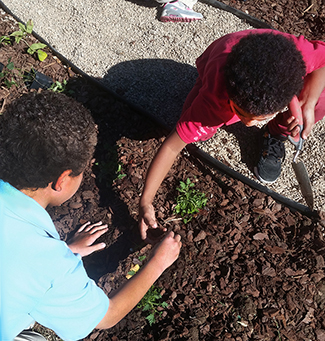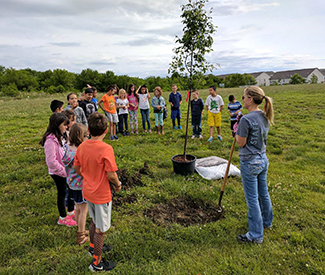Bridging the Gap Green Infrastructure Programs

How does this project advance the three pillars of sustainability — social equity, economic vitality and environmental stewardship?
Bridging the Gap (BTG) operates several programs and initiatives — the Heartland Tree Alliance (HTA), Kansas City WildLands and Milkweed for Monarchs — that enhance the region’s green infrastructure. These efforts have resulted in the planting of thousands of new trees across the metro, the installation of native plants which can help reduce urban flooding, and the restoration of remnant prairies on public lands. Trees have been shown to enhance social equity by improving air quality and decreasing rates of crime in the urban core. Public education and engagement are central to BTG’s mission. Consequently, all these programs enhance environmental stewardship by educating individuals and businesses about the benefits of green infrastructure and engaging volunteers in the work of planting trees and native plants.

to grade-school children.
Project Goals:
The broad goal of BTG’s green infrastructure programs and initiatives is to make the region a greener, healthier, more vibrant and biodiverse place. BTG promotes planting trees to improve public health, reduce energy consumption in buildings, enhance property values and combat the urban heat island effect that contributes to air pollution in the summer. Its native planting programs help to mitigate urban flooding, improve water quality in streams and rivers, and reduce the need for traditional turf maintenance, which contributes to air pollution and the eutrophication (process of excess nutrient deposits that cause dense growth of plant life/algal blooms, depleting available oxygen for aquatic wildlife) of water bodies. A greater diversity of trees and plants in urban areas also creates habitat for wildlife and pollinators, which are essential for a healthy ecosystem. An overarching goal of these programs is to educate the public about the multiple benefits that trees and native plants provide, and to engage them in efforts to create a more biodiverse region.
Project Description:
HTA promotes tree planting on public lands and is increasingly taking a role in instigating planting on private lands too. They sponsor planting workdays and training sessions to educate the public about tree planting and maintenance, distribute trees to individuals and community groups for planting, and offer educational presentations to area fourth- through sixth-grade classes. In the past year, Bridging the Gap has played a leading role in the creation of a Master Tree Plan for the city of Kansas City, Missouri, and trees are expected to play a leading role in cooling our city.
KC WildLands coordinates with local governments and employs volunteers to restore remnant prairie on publicly-owned lands. It also harvests and distributes native plant seeds to expand the footprint of restoration projects.
Through Milkweed for Monarchs and a biannual plant sale, BTG has distributed native plants to residents for planting in area yards.
Community Benefits and Lessons Learned:
Since 2002, HTA has planted more than 20,000 trees, and BTG has facilitated the planting of 175 monarch gardens. KC WildLands has restored 450 acres of remnant prairie that attract 68 species of native bees.
Funding Sources and Partnerships:
BTG relies on a variety of grants, sponsorships and donations to implement its green infrastructure programs. The city of Kansas City, Missouri’s Parks Department is a major funder of Heartland Tree Alliance and supports prairie restorations in its parks. The Missouri Department of Conservation is a major supporter of Kansas City WildLands, and Johnson County Park & Recreation District, the U.S. Forest Service, Shumaker Family Foundation, Dunn Family Foundation and Cargill are all key funders and supporters of BTG’s green infrastructure work. BTG also relies on contributions from businesses and individuals to support its programs. Finally, the importance of the numerous volunteers who donate their time to assist with planting trees and native plants cannot be overstated.
